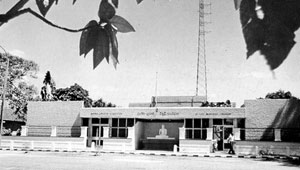We all listen to SLBC – the government radio. SLBC stands for Sri Lanka Broadcasting Corporation which administers the State radio in the country.
It was on January 5, 1967 that the Department of Broadcasting was
transformed into the
statutory form of a State corporation by the Ceylon Broadcasting Corporation Act No. 37 of 1966 passed by Parliament. With the new status of a corporation, it gained more autonomy to run its affairs and more flexibility in the operations.
Ceylon Broadcasting Corporation, as it was
originally known, became SLBC with the change of the country's name to Sri Lanka when it became a republic in May 1972.
What began as an
experimental project
by the Telegraph Department way back in 1923 by a few engineers with the aid of a small transmitter from the radio equipment of a captured German submarine proved successful. On December 16, 1925, a regular
broadcasting service came to be instituted. A Medium Wave radio transmitter of one kilowatt of output power was used from Welikada, Colombo.
Over a period of 40 years, it had turned into a fully equipped broadcasting
station. It is significant that the experiments were begun in 1923 just three years after the
inauguration of
broadcasting in Europe and the launch of BBC (British Broadcasting Corporation) in London. 'Colombo Radio' as it was originally called, was the first ever radio
station in Asia.
From July 1924,
broadcasts were given twice or thrice a week depending on the
availability of programme material. News, universal time signals and weather reports were soon added but the limitation was the range and effectiveness of the transmission which depended on a low power small experimental set.
Gradually the station expanded with the
introduction of short wave transmissions for better reception in areas outside a 40-mile radius of Colombo. The building at Torrington Square which houses the main station to this day was built and occupied in 1949. By 1940 the number of license holders stood at 10,000 and two years later had risen to 27,000. (The system of obtaining annual licenses was discontinued a few years back).
Until the corporation was formed, the State radio was known as 'Radio Ceylon.'
SLBC continued to rely on medium wave as the
primary mode of domestic broadcasting until 1993 when 'the FM Stereo Broadcasting Facility at Colombo' was
commissioned with the technical assistance of the government of Japan. By 1999, more than 95%
country's total population was being covered by SLBC's FM transmissions with nearly 90% of them receiving all six nationwide channels.
The six channels are:
- 'Swadeshiya Sevaya' (Sinhala National Service)
- Tamil National Service
- English Service
- City FM (Sinhala)
- 'Velenda Sevaya' (Sinhala Commercial Service), and
- 'Thendral' (Tamil Commercial Service)
SLBC also operates on a nationwide basis a seventh channel, namely the 'Sports Service,' which is dedicated for sports, but only during the times of major sports events such as
international cricket matches.
SLBC operates four Regional Services, each originating from respective regional studio centres, and five Community Radio
services, operated in five specific areas with
substantial socio economic homogeneity. All these services largely represent a public service broadcasting format with regional
community focus.
In addition to the above domestic services, SLBC is also operating a host of overseas services,
transmitting in shortwave to the South & South-West Asia and the Middle East, in Sinhala, English, Hindi and several Indian
sub-continental languages. Also, there is a medium wave transmitting facility for broadcasting mainly to the Southern regions of India.
SLBC's mission was to maintain public service broadcasting in Sri Lanka, by way of providing the public with the information and entertainment, and
fostering the social, cultural and economic development of the country. This policy has been maintained as the core guiding principle of its programming policy.
Expansion of radio
In recent years,
broadcasting has expanded at a tremendous pace.
With the introduction of radio sets worked on torch
batteries, more and more people began listening to the radio. The convenience coupled with the thirst for news as well as treating radio as a mode of cheap entertainment resulted in a huge expansion of the
listenership.
At least 18 FM channels operate today. They are:
- Asura FM
- City FM
- Hiru FM
- Kotmale Community Radio
- Lakhanda
- Max Radio
- Neth FM
- Rangiri FM
- Real Radio
- Sha FM
- Sri FM
- Shakthi FM
- Sirasa FM
- Siyatha FM
- TNL Radio
- ‘V’ FM
- ‘Y’ FM
- Yes FM
|

